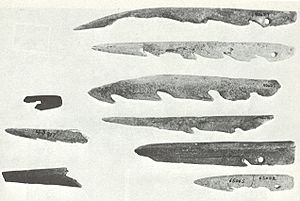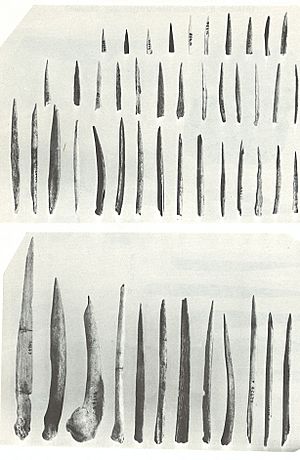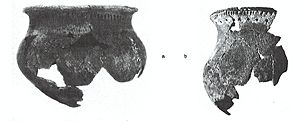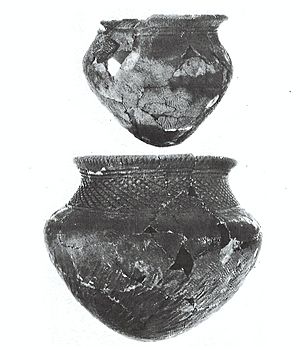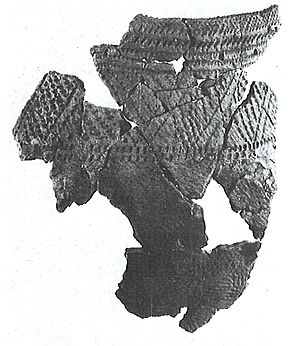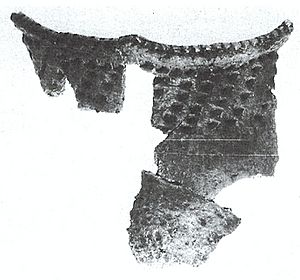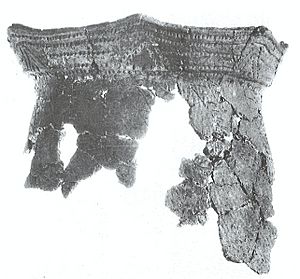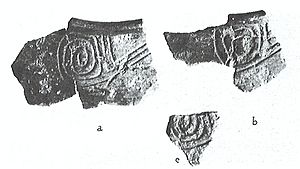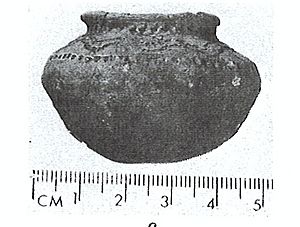Juntunen Site facts for kids
Quick facts for kids |
|
|
Juntunen Site
|
|
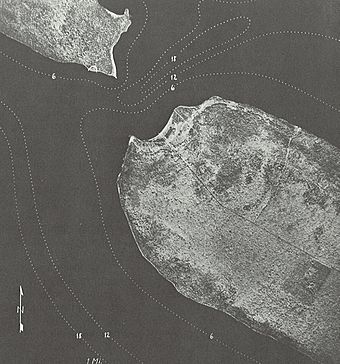 |
|
| Location | Western tip of Bois Blanc Island |
|---|---|
| Area | 2 acres (0.81 ha) |
| NRHP reference No. | 78001504 |
| Added to NRHP | March 21, 1978 |
The Juntunen Site, also known as 20MK1, is an ancient Prehistoric fishing village. It was used by people during the Late Woodland time. This important archaeological site is located on the western tip of Bois Blanc Island. It was added to the National Register of Historic Places in 1978.
Contents
About the Juntunen Site
The Juntunen site is found on a low sandy beach. It is about 600 feet from the lake and 17 feet above the water. This large area, about 2 acres, was a seasonal fishing camp. People likely used it mainly in the fall, similar to the nearby Scott Point Site.
The site also has five ossuaries. These are places where many human bones were buried together. An infant burial and other bones found on the surface were also here. People used this site during the Late Woodland period, from about 800 A.D. to 1400 A.D. Most of the burials are from 1200 to 1400 A.D.
Because people visited the site often but only for certain seasons, many layers of archaeological remains built up. There are up to 25 different layers, like pages in a history book. Each layer tells us about a different time.
Discovering the Juntunen Site
The Juntunen Site was first found in 1932. Robert Braidwood from the University of Michigan discovered it. He saw human bones appearing from the ground in some mounds. Digs, called excavations, were done over the next few years.
In 1959, Mr. Charles Juntunen, who owned the land, found more bones. He was using a bulldozer to build a road. Mr. Juntunen told the University of Michigan. Then, Alan McPherron and James Griffin from the University led more excavations. These important digs happened from 1960 to 1963.
What Was Found at Juntunen
The excavations found many interesting things. They uncovered old fireplaces, pits, and human burials. They also found Prehistoric artifacts, animal bones, and plant remains.
The archaeologists found 25 layers of soil. These layers showed six times when people lived there. They also showed three main periods, with two times when the site was empty for a while.
- Mackinac Phase: Around 800 A.D. - 910 A.D. (Layers I-XIV)
- Bois Blanc Phase: Around 1000 A.D. - 1200 A.D. (Layers XVI-XIX)
- Juntunen Phase: Around 1250 A.D. - 1400 A.D. (Layers XXII-XXV)
Features of the Site
Archaeologists found different features at the site. These included hearths (old fireplaces) and pits of different sizes. They also found animal burials, including dogs, snowshoe hares, and bald eagles.
Hundreds of "post molds" were found. These are marks left in the ground where wooden posts once stood. They showed the outline of one longhouse, a long building where many families might have lived. Other buildings were not clear.
Human Burials
A total of 65 human burials were found. Some of these were in ossuaries, which are shared burial pits. Finding ossuaries here shows that these ancient people had burial customs similar to later groups. For example, the Huron people had a "Feast of the Dead" ceremony.
Interestingly, 10 of the 65 burials had a piece of bone removed from the cranium (skull). This practice is not seen in later historical records. It tells us about a unique ancient custom.
Animal Bones Found
Most of the animal bones found were from fish. About 85% of all bones belonged to fish species. The main fish found were sturgeon and whitefish. Other animal bones included beaver, bald eagle, dog (some were food, some were ceremonial burials), loon, and walleye.
These bones were mostly "unmodified," meaning they were not shaped into tools. They are believed to be leftovers from meals.
Plant Remains Found
Archaeologists also found several plant remains at the site. These included birch bark, hazelnut, maize (corn), fire cherry, and blackberry. The Juntunen site is the furthest north that maize has been found in prehistoric archaeological records. This shows how far corn farming had spread.
Tools and Artifacts
Many artifacts were found at the Juntunen site. These include:
- Pottery: Over 100,000 pieces of broken pottery were found. These came from at least 631 different pots!
- Stone tools: This includes 245 scrapers (used for cleaning hides) and 198 projectile points (like arrowheads or spear tips). Many of these were triangular "Juntunen points."
- Ground stone artifacts: 11 tools made by grinding stone, such as celts and adzes (types of axes).
- Bone tools: 120 tools made from bone, including 69 awls (for piercing) and 9 harpoon heads (for fishing).
- Copper artifacts: The Juntunen site is special because it's the only known place where copper was made into tools during the Late Woodland time. They found 776 copper items, including raw materials and waste. The most common finished copper tools were awls (57) and beads (25).
One person buried in an ossuary had a very unusual "personal kit." It contained tools, animal skins, bones, a red stone tablet, and a fire-starting kit. No other burials had items with them. This suggests this person might have been important, perhaps a shaman or medicine man (a spiritual leader).
Ancient Pottery Styles
Because so many pottery pieces were found, and because they were in different layers, researchers could learn a lot. They could see how pottery styles changed over time and how people at Juntunen were connected to other groups.
Three main pottery styles were made by the people living at Juntunen: Mackinac, Bois Blanc, and Juntunen. Also, four "foreign" pottery styles were found. These came from other cultures: Blackduck, Point Sauble, Upper Mississippian Oneota, and Middle Mississippian Ramey ware. A few other rare types were also present.
Small, miniature pots were also found. There were 91 pieces from at least 21 tiny pots. These small pots are common at other sites nearby. They might have been "toy" pots for children, or perhaps young potters practiced making them.
Mackinac Ware
This pottery style is from the earliest period at Juntunen. It has rounded pots with clear "shoulders" (where the pot curves inward). The clay often had coarse grit mixed in. The outside usually had marks from a cord-wrapped paddle. Decorations were made with cords or sharp tools.
Bois Blanc Ware
This pottery style came after Mackinac Ware. These pots were also rounded but did not have the strong "shoulders." They were decorated with cord-wrapped sticks or twisted cords. The rims (tops) were often thickened and sometimes had "castellations," which are raised points like on a castle wall.
Juntunen Ware
This is the latest pottery style made at the site. These pots had round bodies without strong shoulders. They used fewer cord decorations. The rims were often "collared" (a band around the rim) and flared outwards. Decorations included "punctate" (dots) and "drag-and-jab" (lines made by dragging and pushing a tool). This pottery is similar to styles found in southern Ontario.
Blackduck Ware
Blackduck pottery came from a culture to the north, around Lake Superior. It has rounded pots with curved rims. The surfaces were often marked by cords and decorated with cord-wrapped sticks or dots. Blackduck pottery was found in the earlier layers at Juntunen.
Point Sauble Collared
This pottery style is linked to the Effigy Mound culture in eastern Wisconsin. It has cord-marked surfaces and decorations on the rim and neck. The rims were often "braced" (strengthened). Some pieces found at Juntunen had angular openings, like those found at the Aztalan site in Wisconsin.
Ramey Incised
Only a few pieces of Ramey Incised pottery were found, but they are very important. This style came from the Middle Mississippian culture far to the south, near the Cahokia site in Illinois. Finding it at Juntunen means it's the northernmost place where this pottery has ever been found. It has a unique pattern of curved designs.
Oneota Ware
Oneota pottery came from the Upper Mississippian culture in Wisconsin and nearby states. Most Oneota pottery is made with crushed shell mixed in the clay. But at Juntunen, almost all the Oneota pieces had grit (sand or crushed rock) mixed in instead. These pots had flared rims and smooth surfaces. Their lips (the very top edge) were often wavy or pinched.
Why the Juntunen Site is Important
The Juntunen Site gives us a detailed look at how cultures developed during the Late Woodland time, from about 800 A.D. to 1400 A.D. Because of its central location near the Great Lakes, and because water travel was so important back then, the site shows influences from all directions.
- The Mackinac and Bois Blanc pottery styles show connections to cultures in Wisconsin.
- The Juntunen pottery style shows influence from Ontario and the Iroquois people.
- Blackduck pottery shows influence from the north.
- The Middle Mississippian pottery shows influence from the south.
Juntunen is also the northernmost site where maize (corn) has been found from prehistoric times.
The site also gives clues about customs that later became part of historical Native American tribes. For example, the ossuary burials might be an early form of ceremonies like the Huron Feast of the Dead. This ceremony became more complex after Europeans arrived and the fur trade changed Native American cultures.
The "medicine kit" found with one burial, and the bald eagle burial, are similar to practices of religious groups in later tribes. Examples include the Midewiwin Society of the Algonkian tribe or the False Face Society of the Iroquois. The practice of removing a piece of the cranium from some burials shows a Prehistoric religious practice that seems to have disappeared by historical times.
Researchers studied the animal bones and plant remains to figure out when people used the site. They found that people likely lived there from May through October. This time fits with when sturgeon spawn (lay eggs) in late spring to early summer, and whitefish spawn in the fall. These two fish types make up most of the animal bones found.
Finally, the copper industry at Juntunen is very special for the Late Woodland time. Copper was not used as much for tools during this period. The last time copper was so important was in the much older Archaic Old Copper Culture (around 3000 B.C. to 1000 B.C.).





